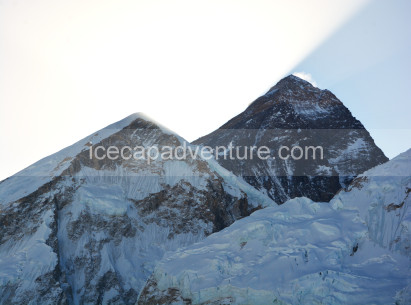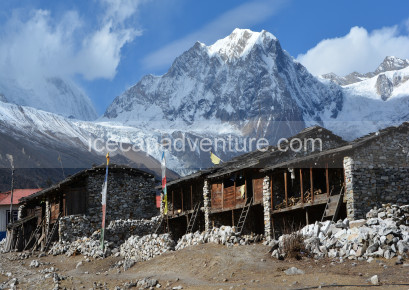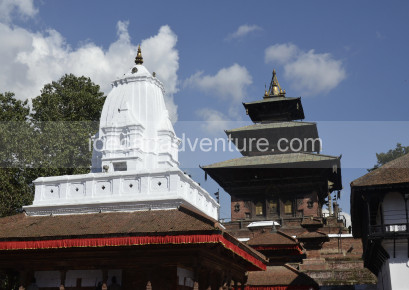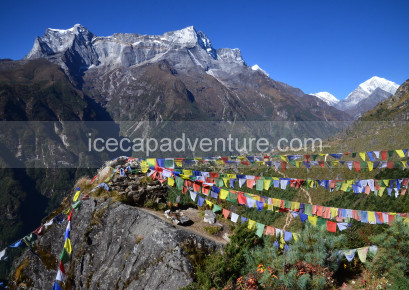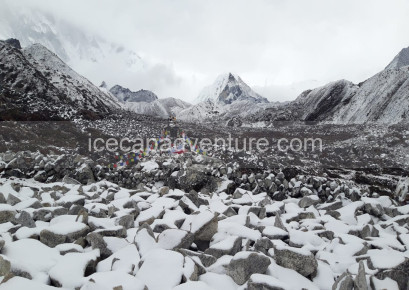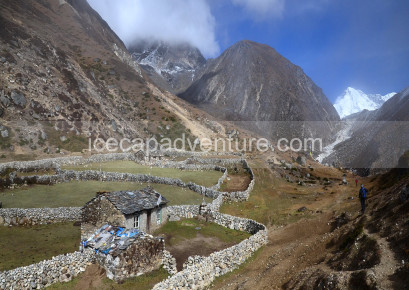.png)
.png)
.png)
.png)
.png)
.png)
.png)
.png)
Numbur Cheese Circuit Trekking Overview
Numbur Cheese Circuit Trekking is a relatively new and less-crowded trekking route in eastern Nepal that combines natural beauty, adventure, and cultural exploration. Named after Mt. Numbur (6,959m) and the famous local cheese of Ramechhap, this trek is perfect for travellers who want an authentic Himalayan experience without the heavy crowds of popular trails. The journey passes through terraced hillsides, rhododendron forests, glacial lakes, and traditional Sherpa villages, offering a rich mix of landscapes and culture.
Landscapes and Wildlife
The trek showcases diverse terrain, from subtropical valleys to high-altitude pastures. Highlights include glacial lakes such as Dudh Kunda and Panch Pokhari, alongside panoramic views of Numbur, Everest, Gaurishankar, and Annapurna ranges. The route also passes through protected areas, home to Himalayan thar, musk deer, langurs, and a variety of birds, making it ideal for nature enthusiasts.
Trekking Experience
The Numbur Cheese Circuit is considered moderate to challenging, typically taking 14–16 days to complete. Trekkers must navigate steep ascents, suspension bridges, and high passes such as Gyazo La (4,880m) and Lakhe Bhanjyang (3,300m). While the route demands physical fitness, the rewards include peaceful trails, pristine wilderness, and fewer trekkers compared to popular regions like Everest and Annapurna. Teahouses are available in villages, though in some sections camping may be necessary, giving the trek a truly adventurous feel.
Best Seasons to Visit
The best seasons are spring (March–May) and autumn (September–November). In spring, rhododendrons light up the forests with vibrant colours, while autumn offers clear skies and crisp mountain views.
Cultural Significance
The trek passes through villages inhabited by Sherpa, Tamang, and other ethnic groups, offering rich cultural immersion. Trekkers can visit monasteries, explore yak pastures, and even sample the famous yak cheese produced in the region. Local hospitality adds warmth and authenticity to the journey.
Highlights of the Trek:
-
Spectacular views of Numbur Himal, Everest, and Gaurishankar.
-
Visit sacred lakes like Dudh Kunda and Panch Pokhari.
-
Crossing high mountain passes with stunning panoramas.
-
Cultural immersion in Sherpa and Tamang villages.
-
Taste of the region’s renowned yak cheese.
1
We will be waiting to welcome you at Tribhuvan International Airport, Kathmandu, where you will be greeted with a traditional Nepali flower garland to mark your arrival. After the warm welcome, we will drive you to your hotel, approximately 30 minutes during the day and 20 minutes at night.
Upon reaching the hotel, you will be offered welcome drinks and biscuits, followed by the settlement of your rooms. Once settled, please join us back in the lobby or meeting hall for a briefing about your trekking and tour program, including an introduction to your trekking guide and other relevant details.
After the briefing, you will have the opportunity to check your trekking equipment with your guide, and we will also explain the trek.
Note: If you arrive in Kathmandu at night, these activities will be scheduled for the following day after breakfast and meals.
.png)
.png)
.png)
.png)
2
After breakfast at the hotel, you will have time to explore Kathmandu’s cultural heritage sites, such as Kathmandu Durbar Square, Swayambhunath (Monkey Temple), or Boudhanath Stupa, and you will have the day to prepare for your trek.
Our team will assist you in checking your gear and ensuring you have all the necessary equipment for the journey ahead. If you need to buy or rent any trekking gear, we will guide you to the best shops in Thamel, where you can find quality items at reasonable prices.
In the evening, your trekking guide will conduct a final briefing about the trek, including route details, safety measures, and expected weather conditions. Overnight stay at a hotel in Kathmandu.
.png)
.png)
.png)
.png)
3
After an early breakfast in Kathmandu (1,350 m), begin your journey with a long but scenic drive to Shivalaya (1,790 m). The route covers about 187 kilometers over 8–9 hours, passing through winding mountain roads, terraced hillsides, and small rural towns. Along the way, you’ll enjoy stunning views of the Bhote Koshi River, rolling green valleys, and scattered traditional villages. Shivalaya serves as an important gateway for trekkers heading into the Rolwaling and Everest regions. Upon arrival, settle into a cozy teahouse, enjoy a warm meal, and prepare for the trek ahead.
Highlights of the Day:
-
Scenic 187 km drive from Kathmandu to Shivalaya.
-
Views of the Bhote Koshi River, terraced fields, and lush valleys.
-
Insight into local roadside villages and rural Nepalese life.
-
Arrival at Shivalaya (1,790 m), the starting point for treks.
-
Overnight stay in a traditional mountain teahouse.
.png)
.png)
.png)
.png)
4
Leaving Shivalaya (1,790 m) after breakfast, the trek begins with a steady climb along terraced fields, charming hamlets, and pine-covered hills. The journey takes about 4–5 hours and offers glimpses of traditional Tamang and Sherpa villages, where locals practice subsistence farming and pastoral life. The trail meanders through forests and cultivated land, rewarding trekkers with views of the surrounding Rolwaling hills and valleys. After a gradual ascent, you’ll arrive in Khahare (2,174 m), a small settlement known for its peaceful atmosphere and welcoming teahouses.
Highlights of the Day:
-
Trek through terraced farmland, pine forests, and small villages.
-
Interactions with local Tamang and Sherpa communities.
-
Views of rolling green hills and valleys of the Rolwaling region.
-
Arrival at Khahare (2,174 m), a quiet trekking stop with teahouses.
-
Experience authentic rural Nepalese lifestyle and hospitality.
.png)
.png)
.png)
.png)
5
After breakfast in Khahare (2,174 m), the trail gradually ascends through dense forests of rhododendron, pine, and oak, creating a serene atmosphere as you trek deeper into the Rolwaling region. The hike takes about 4–5 hours, steadily gaining altitude and offering breathtaking views of the surrounding green valleys, cascading waterfalls, and distant Himalayan ridgelines. Along the way, you may encounter local herders with their yaks and goats. The day’s journey ends at Panipakha (3,108 m), a scenic campsite and resting stop surrounded by alpine vegetation, perfect for stargazing in the crisp mountain air.
Highlights of the Day:
-
Ascend through lush forests of rhododendron, pine, and oak.
-
Peaceful trekking environment with chances to spot birds and wildlife.
-
Scenic views of valleys, ridges, and cascading streams.
-
Arrival at Panipakha (3,108 m), a beautiful alpine campsite.
-
Evening in a tranquil setting with clear mountain skies.
.png)
.png)
.png)
.png)
6
From Panipakha (3,108 m), the trail continues with a gradual yet steady ascent through alpine meadows, mossy forests, and rocky ridgelines. The trek lasts about 5–6 hours, offering a mix of steep climbs and gentler stretches. Along the way, you’ll pass through yak pastures and may spot local herders tending their livestock. The scenery opens up into panoramic views of snow-capped Himalayan peaks, making this section both challenging and rewarding. By late afternoon, you’ll reach Maanedanda (3,940 m), a high-altitude campsite surrounded by breathtaking landscapes, perfect for an evening of stargazing and mountain serenity.
Highlights of the Day:
-
Trek through alpine pastures, meadows, and rugged ridges.
-
Stunning views of the Rolwaling Valley and Himalayan peaks.
-
Encounter local yak herders and highland grazing areas.
-
Arrival at Maanedanda (3,940 m), a remote and scenic high camp.
-
Peaceful evening under clear mountain skies.
.png)
.png)
.png)
.png)
7
Leaving Maanedanda (3,940 m), the trail ascends steadily into the higher Himalayan terrain, taking about 5–6 hours to reach Panch Pokhari (4,515 m). The path winds through alpine ridges, rocky landscapes, and sparse vegetation, offering sweeping views of the Rolwaling Himalayas and surrounding peaks. Panch Pokhari, meaning “five sacred lakes,” is a holy pilgrimage site for both Hindus and Buddhists, believed to hold great spiritual significance. Upon arrival, you’ll be rewarded with the crystal-clear waters of the lakes shimmering against the dramatic mountain backdrop. Camping here provides an extraordinary experience of serenity and spirituality in the heart of nature.
Highlights of the Day:
-
Steady ascent through rugged alpine landscapes and high ridges.
-
Panoramic views of Rolwaling peaks and distant Himalayan ranges.
-
Arrival at Panch Pokhari (4,515 m), a cluster of five sacred lakes.
-
Opportunity to explore the holy site revered by Hindus and Buddhists.
-
Breathtaking high-altitude camping under starry skies.
.png)
.png)
.png)
.png)
8
Today is reserved for rest, exploration, and acclimatization around the sacred site of Panch Pokhari (Five Lakes) at 4,515 meters. This high-altitude destination is a place of deep spiritual significance, where pilgrims gather during Janai Purnima for rituals and blessings. You can spend the day exploring the five crystal-clear lakes, enjoying short hikes around the ridges for panoramic views of the Rolwaling Himalayas, Dorje Lakpa, and Gaurishankar peaks. This excursion also allows your body to adapt to the higher elevation, preparing you for upcoming ascents. The serene environment of the lakes, combined with their cultural and religious importance, makes this day both spiritually and naturally rewarding.
Highlights of the Day:
-
Explore the five sacred lakes of Panch Pokhari.
-
Learn about the religious and cultural significance of this holy site.
-
Short hikes to viewpoints offering Himalayan panoramas.
-
Opportunity to rest and acclimatize at high altitude.
-
Enjoy a tranquil day in the heart of the Himalayas.
.png)
.png)
.png)
.png)
9
After a peaceful night near the sacred lakes of Panch Pokhari (4,515 m), the trail begins with a descent along rocky paths and alpine meadows. The trek lasts about 5–6 hours, leading you through high ridges, yak pastures, and forested sections as you gradually drop to Tare (4,140 m). The journey offers panoramic views of the Rolwaling Himalayas, Dorje Lakpa, and Gaurishankar peaks. Tare is a small but beautiful highland settlement, often used as a resting stop for trekkers and herders, surrounded by grazing fields and alpine vegetation.
Highlights of the Day:
-
Early morning views of the five sacred lakes at Panch Pokhari.
-
Scenic descent through alpine ridges and yak pastures.
-
Views of Dorje Lakpa, Gaurishankar, and Rolwaling peaks.
-
Arrival at Tare (4,140 m), a tranquil high-altitude resting spot.
-
Opportunity to interact with local herders and enjoy the mountain serenity.
.png)
.png)
.png)
.png)
10
From Tare (4,140 m), the trail leads to an adventurous crossing of the Gyazo La Pass, a high mountain pass offering breathtaking views of the Rolwaling Himalayas, Dorje Lakpa, and surrounding snow-capped peaks. The ascent is steep and demanding but relatively short, rewarding you with panoramic Himalayan vistas at the top. After spending some time enjoying the scenery, the trail descends gradually toward Ngeju (3,690 m) through rocky landscapes, alpine meadows, and glacial streams. This section of the trek beautifully combines adventure with cultural immersion, as Ngeju is known for its traditional Tibetan-influenced lifestyle and proximity to remote monasteries.
Highlights of the Day:
-
Exciting ascent to Gyazo La Pass with sweeping mountain views.
-
Majestic panoramas of Dorje Lakpa, Gaurishankar, and Rolwaling peaks.
-
Descent through alpine valleys, pastures, and rocky trails.
-
Arrival at Ngeju (3,690 m), a culturally rich highland settlement.
-
Experience the blend of wilderness and traditional Himalayan culture.
.png)
.png)
.png)
.png)
11
Leaving Ngeju (3,690 m) after breakfast, the trail descends steadily through alpine meadows, rhododendron forests, and cascading streams. The walk takes about 4–5 hours, offering a change in scenery as you drop from high-altitude landscapes into lush valleys. Along the way, you’ll enjoy views of the Rolwaling peaks fading into the distance, and pass through yak pastures and small seasonal herder settlements. The day ends at Lhachhewar (2,665 m), a picturesque Sherpa village surrounded by terraced fields and traditional stone houses. This is an ideal place to experience authentic Himalayan culture and hospitality.
Highlights of the Day:
-
Scenic descent from high alpine terrain into green valleys.
-
Trek through rhododendron and pine forests.
-
Beautiful views of the Rolwaling Himalayas.
-
Arrival at Lhachhewar (2,665 m), a traditional Sherpa village.
-
Cultural interaction with locals and exploration of village life.
.png)
.png)
.png)
.png)
12
After breakfast in Lhachhewar (2,665 m), the trek continues with a steady descent toward the lower Rolwaling Valley. The walk takes about 4–5 hours, leading you through dense rhododendron and pine forests, terraced farmlands, and small traditional villages. Along the trail, you’ll pass chortens, prayer flags, and fields where locals cultivate maize, millet, and potatoes, giving a glimpse of authentic Himalayan rural life. By afternoon, you’ll reach Kyama (2,380 m), a charming settlement surrounded by hillsides and fields. This village offers a peaceful atmosphere and warm Sherpa hospitality, making it an inviting place to rest.
Highlights of the Day:
-
Trek through forests, farmlands, and scattered Sherpa settlements.
-
Scenic views of the Rolwaling hills and valleys.
-
Encounter local cultural landmarks such as prayer flags and chortens.
-
Arrival at Kyama (2,380 m), a traditional Himalayan village.
-
Experience local lifestyle and mountain hospitality.
.png)
.png)
.png)
.png)
13
From Kyama (2,380 m), the trail gradually descends through lush forests, terraced farmland, and traditional Sherpa villages, taking about 3–4 hours to reach Gumdel (2,255 m). Along the way, trekkers pass through small streams, local suspension bridges, and vibrant rhododendron and pine groves. The journey offers glimpses into the daily life of Himalayan villagers, including farming practices, livestock grazing, and local cultural landmarks. Upon arrival in Gumdel, trekkers are welcomed by the village’s warm hospitality and can relax in the teahouses or homestays for the night.
Highlights of the Day:
-
Trek through forests, terraced fields, and small Himalayan settlements.
-
Cross streams and suspension bridges along the trail.
-
Experience local Sherpa culture and daily life.
-
Arrival at Gumdel (2,255 m), a peaceful village with warm hospitality.
-
Scenic mountain and valley views along the way.
.png)
.png)
.png)
.png)
14
Departing from Gumdel (2,255 m), the trail begins with a steady ascent through forests of pine and rhododendron, terraced fields, and small villages, taking about 3–4 hours to reach Serding (3,360 m). The path offers panoramic views of the Rolwaling and surrounding Himalayan ranges, with opportunities to observe yak pastures and local herders along the way. Serding is a high-altitude village with a tranquil setting that provides an excellent spot for rest and acclimatization before continuing toward higher passes or nearby alpine camps.
Highlights of the Day:
-
Steady ascent through pine and rhododendron forests.
-
Stunning views of Rolwaling peaks and alpine landscapes.
-
Pass yak pastures and interact with local herders.
-
Arrival at Serding (3,360 m), a peaceful highland village.
-
Preparation for the next stage of the trek in serene surroundings.
.png)
.png)
.png)
.png)
15
After breakfast in Serding (3,360 m), the trail descends steadily for about 3–4 hours to reach Bhandar (2,190 m). The route passes through forests, terraced farmland, and small traditional villages, offering a glimpse into the daily lives of the local Sherpa and Tamang communities. Along the way, trekkers can enjoy scenic views of valleys, rivers, and distant Himalayan ridges, making this a visually rewarding yet relatively easy day. Upon arrival at Bhandar, you’ll settle into local teahouses or homestays, resting comfortably after the descent.
Highlights of the Day:
-
Gradual descent through forests, terraced fields, and villages.
-
Panoramic views of valleys and Himalayan ridges.
-
Observation of local Sherpa and Tamang village life.
-
Arrival at Bhandar (2,190 m) with warm teahouse hospitality.
-
Relax and prepare for the continuation of the trek.
.png)
.png)
.png)
.png)
16
After breakfast in Bhandar (2,190 m), your trek concludes and you begin the long but scenic 8–9 hour drive back to Kathmandu (1,350 m). The journey follows winding mountain roads, passing through terraced fields, river valleys, and small rural villages. Along the way, you can enjoy panoramic views of the Himalayan foothills, rivers, and local village life. This drive offers a relaxing way to reflect on your Rolwaling trekking adventure, enjoying the landscapes without the physical exertion of hiking. Upon arrival in Kathmandu, you’ll be transferred to your hotel for a well-deserved rest, with the evening free for dinner or souvenir shopping.
Highlights of the Day:
-
Scenic mountain drive through valleys, rivers, and terraced hills.
-
Views of remote villages and rural Himalayan life.
-
Relaxing journey after days of trekking.
-
Arrival in Kathmandu (1,350 m) and hotel transfer.
-
Evening at leisure for shopping, dining, or exploring.
.png)
.png)
.png)
.png)
17
After days of trekking and mountain adventures, today is dedicated to relaxation and leisure in Kathmandu. You can enjoy a slow morning with a hearty breakfast before heading out for shopping in Thamel and other local markets, where you’ll find handicrafts, pashmina shawls, trekking gear, and souvenirs. For those who prefer cultural exploration, optional visits to Pashupatinath Temple, Boudhanath Stupa, or Patan Durbar Square are ideal. You may also choose a spa or massage session to rejuvenate tired muscles. In the evening, enjoy a farewell dinner at a traditional Nepali restaurant, reflecting on the journey through the Himalayas.
Highlights of the Day:
-
Leisure day after trekking, no strenuous activities.
-
Shopping for souvenirs, handicrafts, and trekking gear.
-
Optional visits to UNESCO World Heritage Sites in Kathmandu.
-
Relaxation through spa treatments or massage.
-
Farewell dinner to celebrate your trek.
.png)
.png)
.png)
.png)
18
After breakfast at your hotel in Kathmandu (1,350 m), your unforgettable Himalayan adventure concludes. Our team will assist with your transfer to Tribhuvan International Airport for your flight home or onward travel. Depending on your flight schedule, you may have time for a short walk in Thamel or last-minute shopping for souvenirs. As you leave Nepal, you carry with you the memories of stunning mountain landscapes, cultural encounters, and warm local hospitality.
Highlights of the Day:
-
Hotel check-out and airport transfer.
-
Optional last-minute shopping or city stroll.
-
Farewell to Nepal’s Himalayan landscapes and vibrant culture.
-
Departure for your final destination.
.png)
.png)

Didn’t find what you were looking for?
So why not plan your own trip. It takes only 2 minutes.- Airport Pick up and transfers to hotel.
- All accommodation in Kathmandu and trekking.
- Full board meals during the trekking such as : Breakfast, Lunch & Dinner.
- Properly 3 time tea and coffee whatever hot drink available.
- Full support crew with 1 porter for every 2 trekkers.
- Full insurance for guide and porters.
- Trekking Maps and Notebooks.
- All transportation with AC deluxe from the starting to ending points of the trip.
- National park entry fee and TIMS card or trekking permit whatever needed.
- Down Sleeping bag -20, and Must be returned after completion of trek.
- All taxes as necessaries by Nepal government.
- First Aid Kit for staff.
- Trekking achievement certificate after completed the Treks.
- All international flight tickets, travel insurance and Nepal entry visa fees.
- All international flight tickets, travel insurance and Nepal entry visa fees.
- All hard drinks such as : Mineral water, whisky, rum, cola, fanta, etc.
- Extra entrance fees such as Museum, Monastery, Temple, etc.
- Personal expenses like hot shower and battery charge / wifi.
- Personal equipment
- Extra night hotel in Kathmandu if arriving late or departure than scheduled itinerary.
- Any emergency rescue evacuation and extra cost offering from unfavorable circumstance such as weather bad.
- Personal tips for trekking staff.

✅ Clothing
-
Base Layers (Thermal Tops & Bottoms)
-
Trekking Shirts (Long & Short Sleeves)
-
Fleece Jacket / Warm Mid-layer – For insulation.
-
Down Jacket – Essential for nights above 3,500m.
-
Waterproof & Windproof Jacket (with hood).
-
Trekking Pants (lightweight, quick-drying).
-
Warm Trekking Pants (for high altitude).
-
Waterproof Pants (for rain/snow).
-
Underwear – Comfortable, quick-dry.
-
Sports Bras (for women).
✅ Head & Hand Wear
-
Warm Hat / Beanie and Sun Hat / Cap.
-
Buff / Neck Gaiter / Scarf.
-
Sunglasses and Gloves 2 pairs
✅ Footwear
-
Trekking Boots – Sturdy, waterproof, broken-in.
-
Lightweight Shoes / Sandals – For camp/teahouse.
-
Warm Trekking Socks – At least 4–5 pairs.
✅ Sleeping & Bags
-
Sleeping Bag (Down -15°C) and Liner.
-
Duffel Bag (carried by porter).
-
Daypack (30–40L) – For personal items.
-
Rain Cover for Backpack.
✅ Trekking Gear
-
Trekking Poles & Gaiters – For snow or muddy.
-
Headlamp (with extra batteries).
-
Water Bottles (2–3 liters) and Water Purifications.
-
Personal First Aid Kit
-
Snacks / Energy Bars / Dry Fruits.
✅ Accessories & Personal Items
-
Sunscreen (SPF 30–50) and Lip Balm with SPF.
-
Toiletries and Hand Sanitizer.
-
Towel (quick-dry) and Toilet Paper
-
Camera / Power Bank / Solar Charger.
✅ Documents & Money
-
Valid Passport and Visa.
-
Travel Insurance (cover high-altitude & helicopter rescue).
-
Cash (Nepali Rupees) – For personal expenses.
Good to Know – Numbur Cheese Trekking
-
Best Seasons to Trek: The ideal time is spring (March–May) and autumn (September–November) for clear skies, pleasant temperatures, and excellent mountain views. Winter can be cold and snowy, while monsoon (June–August) brings heavy rain and slippery trails.
-
Altitude Awareness: The trek reaches around 4,200–4,300 meters, so altitude sickness is possible. Gradual ascent, hydration, and rest days are important for acclimatization.
-
Physical Fitness: A moderate trek, requiring 5–7 hours of walking per day on hilly and sometimes steep terrain. Trekkers should have reasonable endurance and stamina.
-
Permits Required: Trekkers need Makalu Barun National Park Permit and a TIMS card, both obtainable in Kathmandu.
-
Accommodations and Meals: Tea houses and lodges along the route provide basic accommodation and meals such as dal bhat, noodles, soups, and some Western dishes. Facilities are more limited in higher villages.
-
Drinking Water: Bottled water is available but expensive at higher altitudes. Carry a water purifier or purification tablets for safe drinking.
-
Packing & Gear: Essentials include layered warm clothing, waterproof jacket, trekking boots, sleeping bag, walking poles, sunscreen, sunglasses, and a personal first-aid kit. Prepare for cold nights and sunny days.
-
Flight & Transportation: Trek starts with a drive from Kathmandu to Kharikhola or Chisapani, followed by trekking. Roads can be bumpy but scenic.
-
Connectivity: Mobile network coverage is limited in remote villages; higher altitudes may have no service. Some lodges may offer paid Wi-Fi.
-
Travel Insurance: Comprehensive insurance covering high-altitude trekking, medical emergencies, and helicopter evacuation is strongly recommended.

